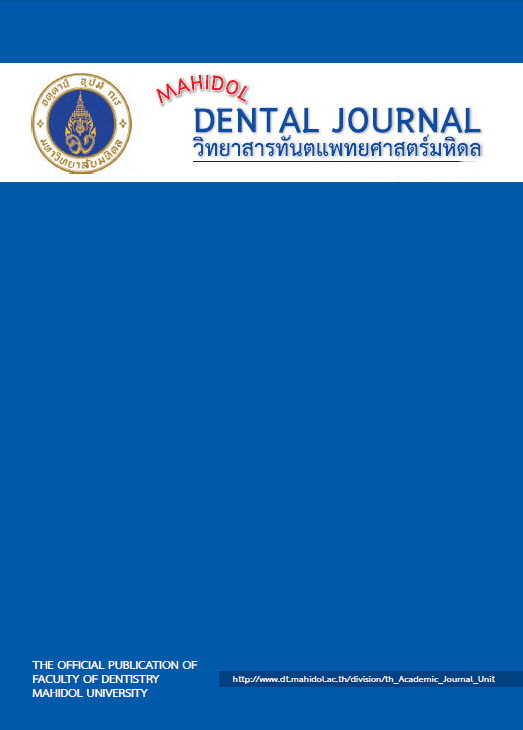Flexural Strength of Three Denture Base Materials in Different Curing Procedures
Main Article Content
Abstract
Objectives: This study compared the flexural strength of three denture base materials when processed under long-curing and short-curing techniques.
Material and methods: Three denture base materials (SR Triplex Hot, Probase Hot and SR Ivocap High Impact) were polymerized in long- and short- curing procedures. Twelve rectangular specimens (10mm x 64mm x 3.3mm) of each material were prepared according to ISO 20795, and stored in distilled water at 37oC for 48 hours. The three-point bending test with a 5 mm/min crosshead speed was carried out using a universal testing machine.
Results: The mean and standard deviation values of flexural strength of SR Triplex Hot, ProBase Hot and SR Ivocap High Impact cured by long-curing procedure were 78.8±2.5, 78.9±2.8 and 73.2 ±4.6 MPa, respectively. Of those cured by short-curing procedure were 76.0±2.6, 77.5±3.0 and 68.1±2.8 MPa, respectively. Two-way ANOVA (∝=0.05) showed that there was no interaction between the two variable – material and curing time. The flexural strengths of SR Triplex Hot and ProBase Hot were significantly higher than those of SR Ivocap High Impact (p<0.05). In addition, the flexural strengths of materials subjected to long-curing procedure were significantly higher than those processed by short-curing procedure (p<0.05).
Conclusion: Flexural strength of SR Triplex Hot and ProBase Hot were higher than that of SR Ivocap High Impact. Longer curing time resulted in higher flexural strength of the denture base materials.
Article Details
References
2. Darvell BW. Material sciences for Dentistry. 9th ed. Woodhead publishing; 2009. 108-77.
3. Kanchanavasita W, Kortrakulkij K. Effect of denture cleanser on color stability and flexural strength of three denture base materials. Mahidol Dent J. 2010;29:24-35.
4. Sunint S, Jayant N, Sanjeev M. Comparative evaluation of surface porosity in conventional heat polymerized acrylic resin cured by water bath and microwave energy with microwavable acrylic resin cured by microwave evergy. Comtemp Clin Dent. 2013;4:147-51.
5. Al Doori D, Huggett R, Bates JF, Brooks SC. A comparison of denture base acrylic resin polymerized by microwave irradiation and by converntional water bath curing systems. Dent Mater. 1988;4:25-32.
6. Bentaher HA, Juszczyk AS, Deb S, Clark RK, Radford DR. Flexural strength and degree of polymerization of a proprietary denture base acrylic resin designed to be cured using long or short cycles. Eur J Prosthodont Restor Dent. 2012;20:163-7.
7. Wolffaaedt FJ, Jones CP, Fatti P. The occurance of porosity in heat cured poly methyl methacrylate denture base resin. J Prosthet Dent. 1986;55:383-400.
8. Hussain S. Textbook of Dental Materials. 1st ed. Chennai: Jaypee Brothers; 2008.
9. Yau W, Cheng Y, Clark R, Chow T. Pressure and temperature changes in heat-cured acrylic resin during processing. Dent Mater. 2002;18:622-9.
10. Maurizio S, Andrea B, Francesca M, Cecilia G, Marco F. Assessment of flexural strength and color alteration of heat-polymerized acrylic resins after simulated use of denture cleansers. J Pros Dent. 2006;8:20-6.
11. Pryos WJ. Injection molding of plastic for dentures. J Am Dent Assoc. 1942;29:1400-8.
12. Garfunkel E. Evaluation of dimensional changes in complete dentures processed by injection-pressing and the pack-and-press technique. J Prosthet Dent. 1983;80:757-61.
13. Anderson GC, Schulte JK, Arnold TG. Dimensional stability of injection and conventional processing denture base acrylic resin. J Prosthet Dent. 1988;60:394-8.
14. Grunewald AH, Paffenbarger GC, Dickson G. The effect of molding processes on some properties of denture resins. J Am Dent Assoc. 1952;44:269-84.
15. SPSS Inc. Released 2009. PASW Statistics for Windows, Version 18.0. Chicago: SPSS Inc..
16. Chitchumnong P, Brooks SC, Stafford GD. Comparison of three- and four-point flexural strength testing of denture-base polymers. Dent Mater. 1989;5:2-5.
17. Stafford GD, Bates JF, Huggett R, Handley RW. A review of the properties of some denture base polymers. J Dent. 1980;292-305.
18. Yunus N, Rashid A, Azumi L, Abu-Hassen M. Some flexural strength properties of a nylon denture base polymer. J Oral Rehabil. 2005;32:65-71.
19. Thomas RM, Mark AL. Physical properties of four acrylic denture base resins. J Contemp Dent Prac. 2005;6:1-5.
20. Barbosa CM, Ribeiro MC. Influence of double flask investing and microwave heating on the superficial porosity surface roughness and knoop hardness of acrylic resin. J Prosthodont. 2009;18:503-6.
21. Jerolimov V, Brooks SC, Huggett R, Bates JF. rapid curing of acrylic denture-base materials. Dent Mater. 1989;5:18-22.
22. Jadhav R, Bhide SV, Prabhudesai PS. Assessment of the impact strength of the denture base resin polymerized by various processing techniques. Indian J Dent Res. 2013;24:19-25.
23. Dogan A, Bek B, Cevik N, Usanmaz A. The effect of preparation conditions of acrylic denture base materials on the level of residual monomer, mechanical properties and water absortion. J Dent. 1995;23:313-8.
24. Huang FM, Hu CC, Chang YC, Chou MY. Residual monomer releasing from acrylic denture base in water. Chin Dent J. 2000;19:17-22.
25. Hurrison A, Huggett R. Effect of th curing cycle on residual monomer levels of acrylic resin denture base polymers. J Dent. 1992;20:370-4.


